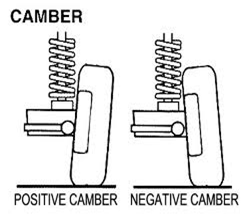Camber
Introduction:
A tires greatest traction is achieved when more of the tread is in contact with the ground. As the bike enters a corner, the forces tend to bend everything over, adding positive camber. To make sure that the tires greatest amount of tread is in full contact when it is most needed, we set up the front suspension with a negative camber.
Camber:
- Camber is the amount of degrees that the tire and wheel is tilted in or out at the top in relation to the bottom of the tire.
- A tire that is tilted in at the top and out at the bottom is said to have negative camber.
- The farther it angles out at the bottom the greater the amount of negative camber.
- For positive camber, the top of the tire is farther out than the bottom.
- With everything in motion, all this force wants to flex the tire more upright, or reducing the amount of negative camber.
- Camber angle is the angle between the vertical line and center line of the tyre when viewed from the front of the vehicle.
POSITIVE CAMBER: Camber angle is positive when this is outward. This happens when wheels are further apart at top than at bottom.
NEGATIVE CAMBER: On the contrary, camber angle is negative when angle is inward. This happens when wheels are further apart at bottom than at top. The camber should not be more than 2o, because this causes uneven or more tyre wear on one side than on other side.
